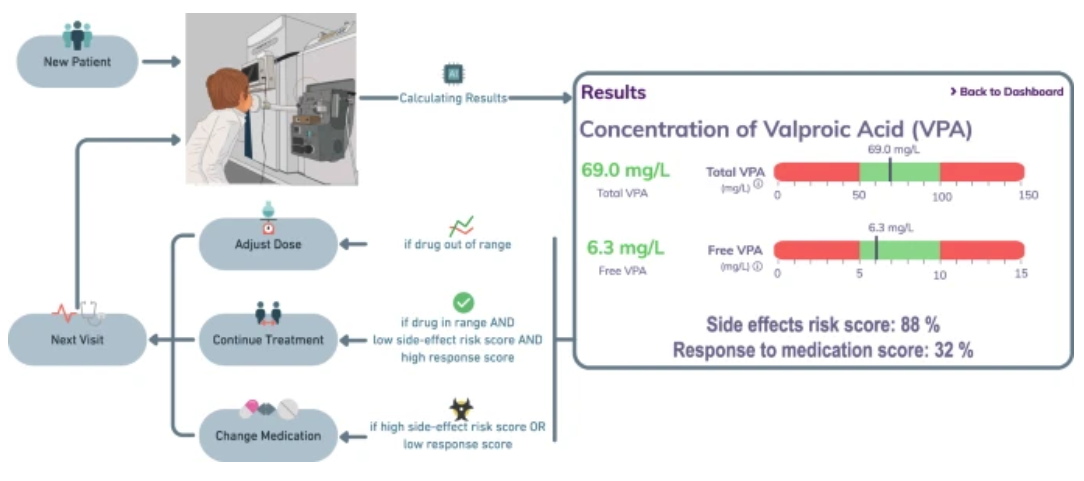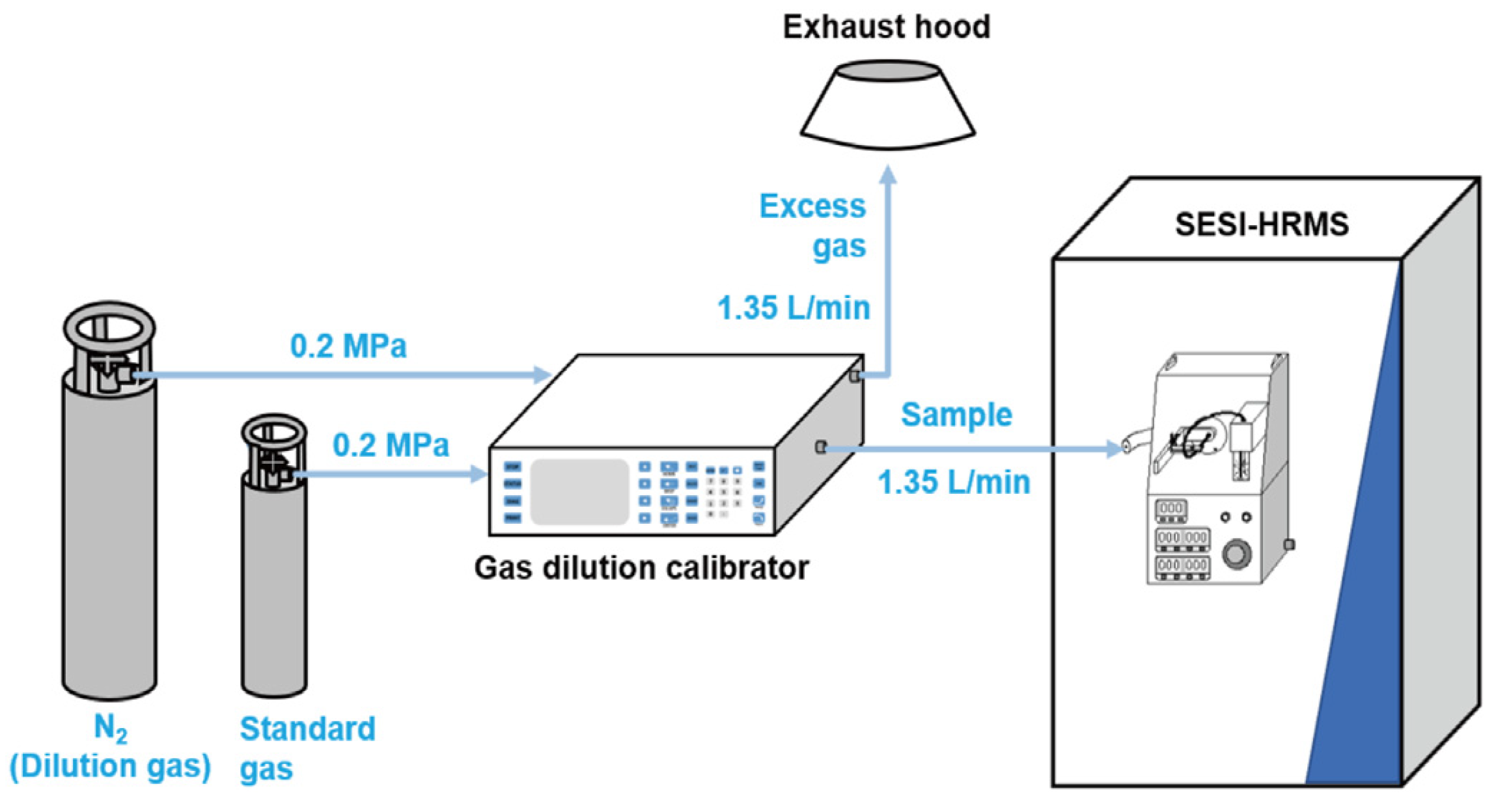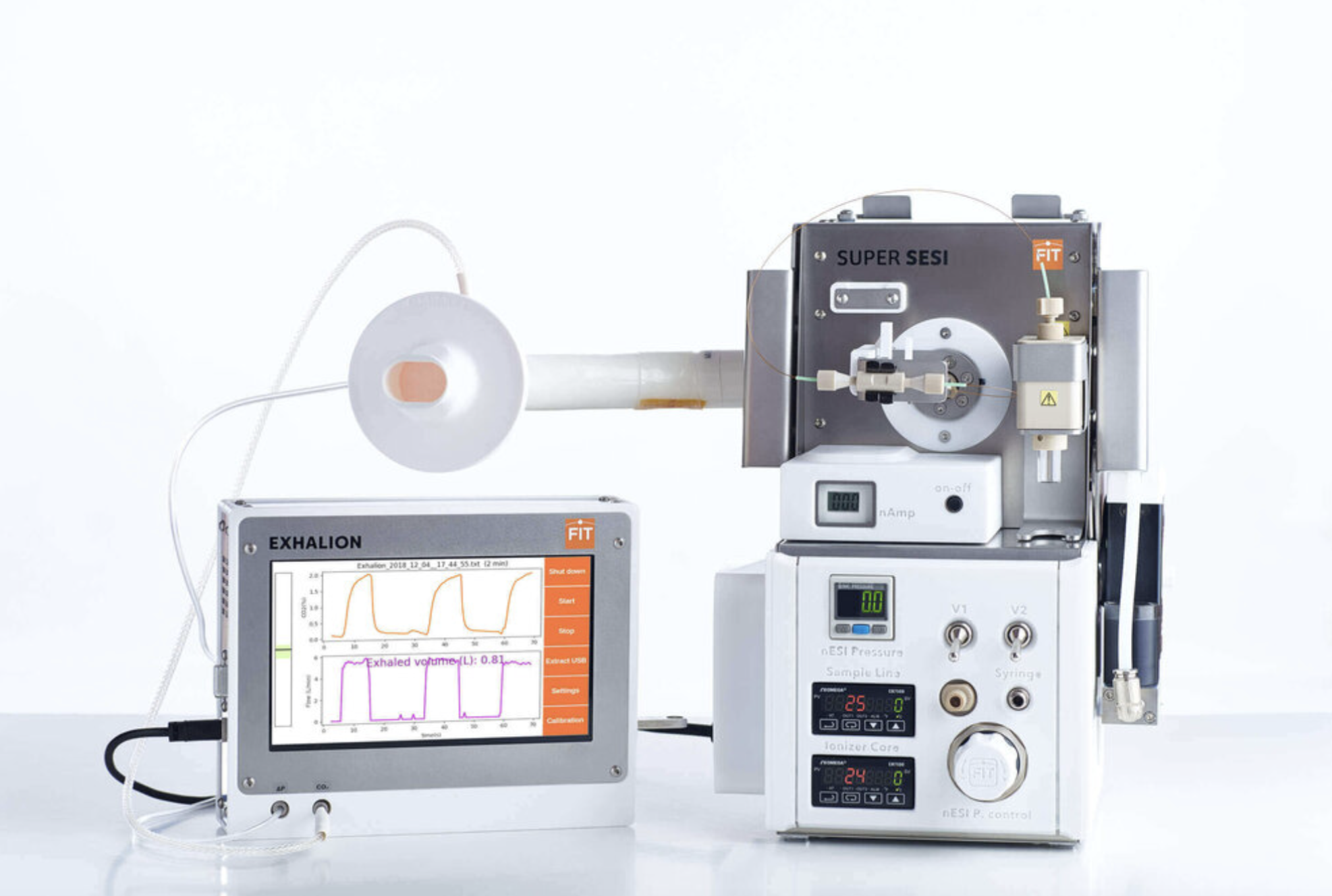Analyses of lung cancer-derived volatiles in exhaled breath and in vitromodels
Fouad Choueiry, Addison Barham, Jiangjiang Zhu
Lung cancer is one of the leading causes of cancer incidence and cancer-related deaths in the world. Early diagnosis of pulmonary tumors results in improved survival compared to diagnosis with more advanced disease, yet early disease is not reliably indicated by symptoms. Despite of the improved testing and monitoring techniques for lung cancer in the past decades, most diagnostic tests, such as sputum cytology or tissue biopsies, are invasive and risky, rendering them unfeasible for large population screening. The non-invasive analysis of exhaled breath has gained attentions as an innovative screening method to measure chemical alterations within the human volatilome profile as a result of oncogenesis. More importantly, volatile organic compounds (VOCs) have been correlated to the pathophysiology of disease since the source of volatile compounds relies mostly on endogenous metabolic processes that are altered as a result of disease onset.
Trends in Direct Breath Analysis by Secondary Electrospray Ionization Mass Spectrometry for Clinical Applications
Bettina Streckenbach
Exhaled breath can reveal insights about the metabolic state of the human body through the endo- and exogenous compounds it contains. The extent of detectable compounds, however, was revolutionized by the application of mass spectrometry. More specifically, secondary electrospray ionization high-resolution mass spectrometry (SESI-HRMS) enables the detection of a broad range of breath-derived compounds simultaneously and with high sensitivity. Together with its rapid and non-invasive nature, direct breath analysis by SESI-HRMS raised particular interest for clinical applications. Over the past years, various clinical trials successfully demonstrated the technology´s capability for biomarker discovery in exhaled breath in adults and more recently in children. Current challenges lie within the potential translation of SESI-HRMS into clinical settings and the requirements therein, such as biomarker identification and validation, which became a focus of more recent studies..
Comparison of Plasma Ionization- and Secondary Electrospray Ionization- High-resolution Mass Spectrometry for Real-time Breath Analysis
Jiafa Zeng, Alexandra Christen, Kapil Dev Singh, Urs Frey, and Pablo Sinues
Real-time breath analysis by high-resolution mass spectrometry (HRMS) is a promising method to non-invasively retrieve relevant biochemical information. In this work, we conducted a head-to-head comparison of two ionization techniques: Secondary electrospray ionization (SESI) and plasma ionization (PI), for the analysis of exhaled breath. Two commercially available SESI and PI sources were coupled to the same HRMS device to analyze breath of two healthy individuals in a longitudinal study. We analyzed 58 breath specimens in both platforms, leading to 2,209 and 2,296 features detected by SESI-HRMS and by PI-HRMS, respectively. 60% of all the mass spectral features were detected in both platforms. However, remarkable differences were noted in terms of the signal-to-noise ratio (S/N), whereby the median (interquartile range, IQR) S/N ratio for SESI-HRMS was 115 (IQR = 408), whereas for PI-HRMS it was 5 (IQR = 5). Differences in the mass spectral profiles for the same samples make the inter-comparability of both techniques problematic. Overall, we conclude that both techniques are excellent for real-time breath analysis because of the very rich mass spectral fingerprints. However, further work is needed to fully understand the exact metabolic insights one can gather using each of these platforms.
UHPLC-MS/MS-Based Identity Confirmation of Amino Acids Involved in Response to and Side Effects from Antiseizure Medications
Mo Awchi, Pablo Sinues, Alexandre N. Datta, Diego García-Gómez, and Kapil Dev Singh
Real-time breath analysis using secondary electrospray ionization coupled with high-resolution mass spectrometry is a fast and noninvasive method to access the metabolic state of a person. However, it lacks the ability to unequivocally assign mass spectral features to compounds due to the absence of chromatographic separation. This can be overcomed by using exhaled breath condensate and conventional liquid chromatography–mass spectrometry (LC–MS) systems.
Pulmonary Delivery of Aerosolized Chloroquine and Hydroxychloroquine to Treat COVID-19: In Vitro Experimentation to Human Dosing Predictions
Kolli, A.R., Semren, T.Z., Bovard, D. et al.
In vitro screening for pharmacological activity of existing drugs showed chloroquine and hydroxychloroquine to be effective against severe acute respiratory syndrome coronavirus 2. Oral administration of these compounds to obtain desired pulmonary exposures resulted in dose-limiting systemic toxicity in humans. However, pulmonary drug delivery enables direct and rapid administration to obtain higher local tissue concentrations in target tissue. In this work, inhalable formulations for thermal aerosolization of chloroquine and hydroxychloroquine were developed, and their physicochemical properties were characterized. Thermal aerosolization of 40 mg/mL chloroquine and 100 mg/mL hydroxychloroquine formulations delivered respirable aerosol particle sizes with 0.15 and 0.33 mg per 55 mL puff, respectively. In vitro toxicity was evaluated by exposing primary human bronchial epithelial cells to aerosol generated from Vitrocell. An in vitro exposure to 7.24 μg of chloroquine or 7.99 μg hydroxychloroquine showed no significant changes in cilia beating, transepithelial electrical resistance, and cell viability. The pharmacokinetics of inhaled aerosols was predicted by developing a physiologically based pharmacokinetic model that included a detailed species-specific respiratory tract physiology and lysosomal trapping.
Data Collection of" Analysis of volatile short-chain fatty acids in the gas phase using secondary electrospray ionization coupled to mass spectrometry"
Cedric Wüthrich, Stamatios Giannoukos
The mass spectrometer used in this study was an Orbitrap Q-Exactive Plus (Thermo Scientific) operated with the manufacturer’s standard control software (ExactiveTune, version 2.9, Thermo Scientific) and Xcalibur (version 4.1. 31.9, Thermo Scientific). Mass calibration was done according to the instrument manual and was always more recent than seven days according to specifications.
Real-Time Monitoring of Metabolism during Exercise by Exhaled Breath
Jérôme Kaeslin, Srdjan Micic, Ronja Weber, Simona Müller, Nathan Perkins, Christoph Berger, Renato Zenobi, Tobias Bruderer, and Alexander Moeller
Continuous monitoring of metabolites in exhaled breath has recently been introduced as an advanced method to allow non-invasive real-time monitoring of metabolite shifts during rest and acute exercise bouts. The purpose of this study was to continuously measure metabolites in exhaled breath samples during a graded cycle ergometry cardiopulmonary exercise test (CPET), using secondary electrospray high resolution mass spectrometry (SESI-HRMS).We also sought to advance the research area of exercise metabolomics by comparing metabolite shifts in exhaled breath samples with recently published data on plasma metabolite shifts during CPET.
New Insights into Online Molecular Characterization of Organic Aerosol in China Using Extractive Electrospray Ionization and Ultrahigh Resolution Mass Spectrometry (EESI-Orbitrap)
Qi, Lu ; Lee Chuan, Ping ; Giannoukos, Stamatios ; Wang, Dongyu ; Li, Zhiyu ; Ran, Weikang ; Ye, Penglin ; Wang, Liwei ; Wang, Meng ; Lin, Yue ; Han, Yuemei ; Wang, Qiyuan ; Baltensperger, Urs ; El-Haddad, Imad ; Cao, Junji ; Prevot, Andre; Slowik, Jay
Despite extensive study, the sources and processes governing the formation and chemical evolution of haze pollution episodes in urban China remain unclear. Real-time molecular characterization of organic aerosol (OA) represents a promising approach to this problem. Extractive electrospray ionization (EESI) mass spectrometry allows real-time detection of individual OA components, while avoiding thermal decomposition and ionization-induced fragmentation. In previous field measurements, the EESI source was coupled with time-of-flight (TOF) mass analyzers, which are limited to a mass resolution of ~12,000 (at 200 m/z)…
Differentiation of Cystic Fibrosis-Related Pathogens by Volatile Organic Compound Analysis with Secondary Electrospray Ionization Mass Spectrometry
Jérôme Kaeslin, Srdjan Micic, Ronja Weber, Simona Müller, Nathan Perkins, Christoph Berger, Renato Zenobi, Tobias Bruderer, and Alexander Moeller
Identifying and differentiating bacteria based on their emitted volatile organic compounds (VOCs) opens vast opportunities for rapid diagnostics. Secondary electrospray ionization high-resolution mass spectrometry (SESI-HRMS) is an ideal technique for VOC-biomarker discovery because of its speed, sensitivity towards polar molecules and compound characterization possibilities. Here, an in vitro SESI-HRMS workflow to find biomarkers for cystic fibrosis (CF)-related pathogens P. aeruginosa, S. pneumoniae, S. aureus, H. influenzae, E. coli and S. maltophilia is described.
Secondary electrospray ionization-high resolution mass spectrometry (SESI-HRMS) fingerprinting enabled treatment monitoring of pulmonary carcinoma cells in real time
Fouad Choueirya, Jiangjiang Zhu
Lung cancer is one of the leading causes of cancer related deaths in the United States. A novel volatile analysis platform is needed to complement current diagnostic techniques and better elucidate chemical signatures of lung cancer and subsequent treatments. A systems biology bottom-up approach using cell culture volatilomics was employed to identify pathological volatile fingerprints of lung cancer in real time. An advanced secondary electrospray ionization (SESI) source, named SuperSESI was used in this study and directly attached to a Thermo Q-Exactive high-resolution mass spectrometer (HRMS).
Combination of exhaled breath analysis with parallel lung function and FeNO measurements in infants
Fabienne Decrue, Kapil Dev Singh, Amanda Gisler, Mo Awchi, Jiafa Zeng, Jakob Usemann, Urs Frey and Pablo Sinues
Breath analysis by secondary electrospray ionization-high resolution mass spectrometry (SESI-HRMS) offers the possibility to measure comprehensive metabolic profiles. The technology is currently being deployed in several clinical settings in Switzerland and China. However, patients are required to exhale directly into the device located in a dedicated room. Consequently, clinical implementation in patients incapable of performing necessary exhalation maneuvers (e.g., infants) or immobile (e.g., too weak, elderly, or in intensive care) remains a challenge. The aim of this study was to develop a method to extend such breath analysis capabilities to this subpopulation of patients by collecting breath samples remotely (offline) and promptly (within 10 min) transfer them to SESI-HRMS for chemical analysis.
Rapid and reversible control of human metabolism by individual sleep states
N.Nowak, T. Gaisl, D. Miladinovic, R. Marcinkevics, M. Osswald, S. Bauer, J. Buhmann, R. Zenobi, P. Sinues, S. A. Brown, M. Kohler
Using exhaled breath analysis by secondary high-resolution mass spectrometry, we measured the human exhaled metabolome at 10-s resolution across a night of sleep in combination with conventional polysomnography. Our subsequent analysis of almost 2,000 metabolite features demonstrates rapid, reversible control of major metabolic pathways by the individual vigilance states. A switch to wake reduces fatty acid oxidation, a switch to slow-wave sleep increases it, and the transition to rapid eye movement sleep results in elevation of tricarboxylic acid (TCA) cycle intermediates. Thus, in addition to daily regulation of metabolism, there exists a surprising and complex underlying orchestration across sleep and wake. Both likely play an important role in optimizing metabolic circuits for human performance and health.
Breath Analysis by Secondary Electro-Spray Ionization - Mass Spectrometry to Interrogate Biologically Significant Metabolites Non-Invasively
Francisco G. Blanco and Guillermo Vidal-de-Miguel
Here, we review the SESI technology development, the different SESI configurations developed, and the standardization procedures described to translate SESI into the clinical environment. Finally, SESI main applications described in the literature with prompt translation into the clinical environment, namely, biomarker discovery or pharmacokinetics and drug monitoring are revised.
Sensitivity of SESI-MS to a range of volatile organic compounds: ligand switching ion chemistry and the influence of Zspray™ guiding E-fields
Kseniya Dryahina, Miroslav Polášek, David Smith, Patrik Španěl
Secondary electrospray ionization (SESI) is currently only semi-quantitative. In the Zspray™ arrangement of SESI-MS, the transfer of ions from near atmospheric pressure to a triple quadrupole is achieved by guiding E-fields that partially desolvate both reagent and analyte ions which must be understood.
Personalised therapeutic management of epileptic patients guided by pathway-driven breath metabolomics
Kapil Dev Singh, Martin Osswald, Victoria C. Ziesenitz, Mo Awchi, Jakob Usemann, Lukas L. Imbach, Malcolm Kohler, Diego García-Gómez, Johannes van den Anker, Urs Frey, Alexandre N. Datta & Pablo Sinues
Therapeutic management of epilepsy remains a challenge, since optimal systemic antiseizure medication (ASM) concentrations do not always correlate with improved clinical outcome and minimal side effects. We tested the feasibility of noninvasive real-time breath metabolomics as an extension of traditional therapeutic drug monitoring for patient stratification by simultaneously monitoring drug-related and drug-modulated metabolites.
Quantification of volatile organic compounds by secondary electrospray ionization-high resolution mass spectrometry
Chao Liu, Jiafa Zeng, Pablo Sinues, Mingliang Fang, Zhen Zhou, Xue Li.
SESI-HRMS has been successfully applied in multiple applications, including breath analysis, animals and plants VOCs emissions, analysis of headspace of cell cultures and indoor and outdoor air. In this study we aim to develop a quantitative method for eight representative VOCs, including ketones (acetone, 2-butanone and 2-pentanone), alkenes (isoprene and α-terpinene) and aromatics (toluene, styrene and mesitylene).
Real-time (on-line) chemical characterisation of thermal aerosols by super secondary electrospray ionization coupled with high-resolution mass spectrometry (Super SESI-HRMS)
T. Živković Semren, S. Majeed, M. Fatarova, C. Laszlo, C. Pak, S. Steiner, A. Kuczaj, A. Mazurov, M. Peitsch, N. Ivanov, J. Hoeng, and P. A. Guy
We used a programmable dual syringe pump (PDSP) connected to a super secondary electrospray ionisation (SESI) system interfaced with a Q Exactive HF mass spectrometer (MS) to detect the main constituents of thermally generated aerosols in real time. The benefits of Super SESI–HRMS for detecting drug aerosolisation from variably prepared in-house formulations with anatabine, azithromycin, chloroquine, favipiravir, and hydroxychloroquine were evaluated.
High-frequency gaseous and particulate chemical characterization using extractive electrospray ionization mass spectrometry (Dual-Phase-EESI-TOF)
Chuan Ping Lee, Mihnea Surdu, David M. Bell, Josef Dommen, Mao Xiao, Xueqin Zhou, Andrea Baccarini, Stamatios Giannoukos, Günther Wehrle, Pascal André Schneider, Andre S. H. Prevot, Jay G. Slowik, Houssni Lamkaddam, Dongyu Wang, Urs Baltensperger, and Imad El Haddad
To elucidate the sources and chemical reaction pathways of organic vapors and particulate matter in the ambient atmosphere, real-time detection of both the gas and particle phase is needed. State-of-the-art techniques often suffer from thermal decomposition, ionization-induced fragmentation, high cut-off size of aerosols or low time resolution. In response to all these limitations, we developed a new technique that uses extractive electrospray ionization (EESI) for online gas and particle chemical speciation, namely the dual-phase extractive electrospray ionization time-of-flight mass spectrometer (Dual-Phase-EESI-TOF or Dual-EESI for short)….
Metabolic Insights Related to Sleep and Circadian Clocks from Mass Spectrometry-Based Analysis of Blood and Breath
Nora Kristina Nowak
Most physiological processes in humans are synchronized with their environment by socalled circadian clocks. These molecular time-keeping machineries are present in almost every cell. While light is the most important external stimulus to reset the circadian clocks, they can also be entrained by other stimuli, such as feeding or rest/activity cycles. Sleep is both, one of the major outputs of circadian clocks and also an independently regulated recuperative neurobiological process.
In vivo monitoring of volatile metabolic trajectories enables rapid diagnosis of influenza A infection
Zhihong Yin, Wenbo Huang, Kapil Dev Singh, Zhaoming Chen, Xing Chen, Zhen Zhou, Zifeng Yang, Pablo Sinues and Xue Li
We report that influenza A virus infection induces changes in odor traits that could be captured by real-time high-resolution mass spectrometry in a living mouse model. The most striking changes in the volatile metabolites may be associated mostly to glyoxylate/dicarboxylate metabolism.





















